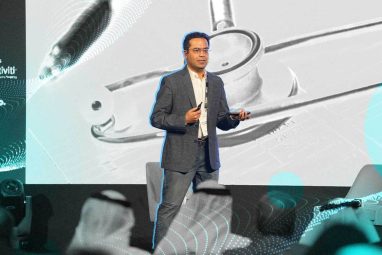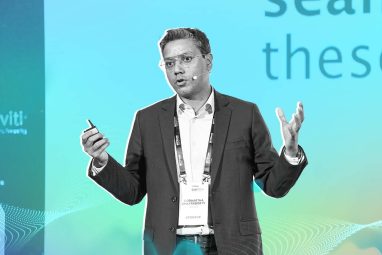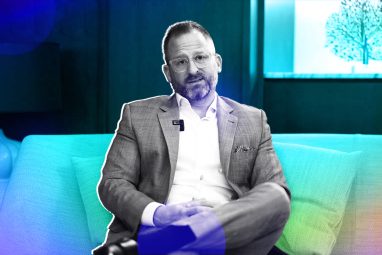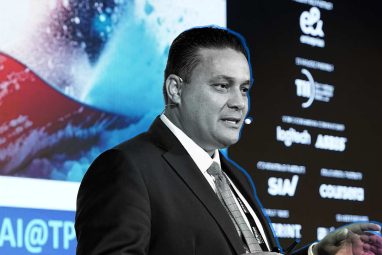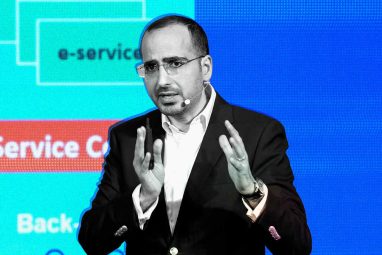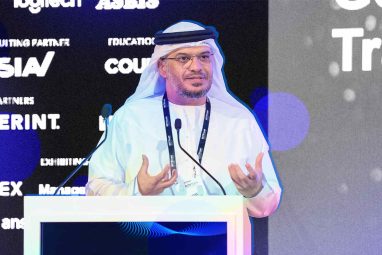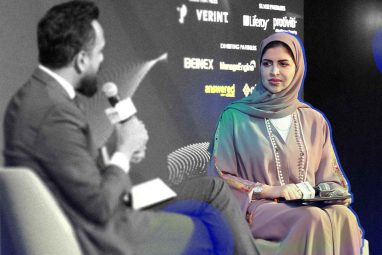Topics
What to Read Next
- UAE Approves National Encryption Policy for a Post-Quantum Shift
- OpenAI API Users Hit With Third-Party Security Breach
- GovTech Conclave 2026 Will Explore the New Frontiers of Government Services
- Uber and WeRide Launch First Driverless Robotaxi Service Outside the U.S. and China
- UAE Unveils Its First Marketplace for Buying and Trading Trademarks
- ACI Flags Sharp Rise in ‘Friendly Fraud’ as Thanksgiving–Cyber Monday Spike Looms
ADNOC’s Ibrahim Al Zu’bi and BCG’s Tamer Obied explore how AI is driving sustainability, efficiency, and innovation in energy—unlocking smarter strategies for net-zero goals and resilient, future-ready operations.
In the fourth episode of More Than Meets the AI—a thought leadership series by MIT Sloan Management Review Middle East in collaboration with Boston Consulting Group (BCG)—AI in Action: Reimagining Energy for a Sustainable Future, the spotlight shifts to the transformative power of artificial intelligence in the global energy transition.
Hosted by Suraya Turk, Managing Partner at Legal Circle, the conversation brings together Ibrahim Al Zu’bi, Group Chief Sustainability & ESG Officer at ADNOC Group, and Tamer Obied, Managing Director & Partner at BCG, to explore how AI is reshaping energy systems, driving decarbonization, and accelerating progress toward net-zero ambitions.
Through practical examples and strategic insights, the discussion covers everything from AI-powered grid optimization and emissions reduction to re-skilling workforces and fostering innovation across the energy value chain. The speakers emphasize that while AI is a powerful enabler, it must be integrated within a larger ecosystem of policy, talent, and collaborative partnerships to unlock its full potential.
This episode explores how one of the world’s leading energy companies is embedding AI into the heart of its net-zero strategy—illustrating what it takes to lead meaningful change in a sector central to the climate challenge.
TRANSCRIPT
Suraya Turk: Hello and welcome to the web series from MIT Sloan Management Review Middle East, in collaboration with BCG. Today we have with us Mr. Ibrahim Al Zu’bi, the Group Chief Sustainability and ESG Officer at ADNOC Group, and Mr. Tamer Obied, Managing Director and Partner at BCG. ADNOC, Masdar, and Microsoft recently released a report on AI and Energy for a Sustainable Future: Powering the Possible. The report explores the role of AI in transitioning to net zero, and it highlights three critical areas: driving efficiency, decarbonizing current energy, and building energy systems for the future. So Tamer, over to you for the first question. Can you tell us a little bit more about the three stages and how AI will impact those stages?
Tamer Obied: I think the report is—one—was quite timely this year, given the big push on AI this year, and a lot of the news that we see that’s happening around the energy for AI. And the report is quite important because it talked about the convergence between technology, it talked about the convergence between the need to hit net zero, and it talked about also the fact that we’re growing energy—will continue to grow in energy demand. And so if I break down those three stages you talked about, one is around driving efficiency, and where we see AI playing a role is helping us to use less energy for the same task, right? And efficiency will be the critical enabler to hit net zero. In fact, it’s one of the outcomes of the COP28 UAE consensus, which is doubling efficiency by 2030. And one of the things we see AI being able to do is, for example, reduce downtime in renewables—up to 20%. And if you extend that out, right, for a one-gigawatt renewable plant, that’s able to really save almost five tons of CO₂ per year. The other thing we see also in efficiency is around transmission and distribution of the molecule itself, right? Depending on the region, you can see energy losses up to 18%, right? So that’s just electrons that completely go to waste—are produced, sometimes are paid for. And we see AI being able to optimize that even down to 5%, right? And if you scale that up, that 5% at roughly almost the emissions intensity of all Australia—it’s 400 million tons per year.
The other stage is on decarbonization—decarbonizing the existing energy system of today. And I think this is important because we need to have all three tracks almost running in parallel. We talk about stages, but we have an energy system where a large amount of CapEx and investment and skill set has gone into over the years to build that—and it’s a pretty reliable one, to be very honest. And so decarbonizing the energy system today is around, you know, methane reduction, is around making sure we deploy new technologies like CCUS. Ibrahim will talk a lot about this and what ADNOC is doing, so I won’t spend so much time. But the other one, where I want to spend maybe a few seconds on, is around building the energy system of tomorrow, right? And that’s something that’s going to happen with technologies that exist today. We’ve got wind, we’ve got solar, we’ve got nuclear. So the technologies are ready today. We’ve got new technologies on the horizon, like small modular nuclear reactors, green hydrogen—which we need to bring down the cost curve—but AI will enable those new technologies. And part of the complexity that comes with the energy system of tomorrow is that it’s going to be much more integrated and it’s going to be much more distributed at the same time, right? And so that brings quite a lot of complexity. And AI is really, really good at complexity—not only doing the analysis, optimizing, but also managing this flexibility, which is going to be needed in the energy system of tomorrow.
Suraya Turk: So Ibrahim, just following from Tamer’s explanation of the three stages—you know he mentioned ADNOC is definitely utilizing AI as well. Can you tell us a little bit more about what ADNOC is doing, what’s its vision for AI and for sustainability, and how it’s using AI to support the decarbonization efforts?
Ibrahim Al Zu’bi: From our perspective as ADNOC, we’ve been embracing AI and technological innovation for some time, and we’ve been transforming the company to be one of the most leading AI-driven companies—energy companies—in the world. Having said that, I look at it as a sustainability practice from two parts. The first one is ADNOC as a company—as you know, the whole world, the whole private sector, and everyone is embracing AI and technology. We understand that. We got this a bit earlier when it comes to our operations. We understand that technological innovation, one, will enhance and increase our efficiency as a company. It will enable us to achieve our targets, but also it will accelerate our ambitions when it comes to sustainability and other issues.
Well, when it comes to sustainability, which is the other layer—I look at it from AI and technology—technology and AI is an enabler to achieve your sustainability targets, period. How we do that when it comes to us—of course, with efficiency, implementing AI and technology in our operations from the control room even to the boardroom—is efficient for us, to ensure that the numbers that we set for us when it comes to GHG reduction, flaring, methane, health and safety—it made a lot of sense for us. So common sense to see an innovation in AI operations in our operations. So for example, we used—from CCTV, we used AI and data analytics when it comes to our ambition to achieve net zero by 2045, 25% by 2030 on our baseline, near-zero methane reduction by 2030. How can I translate this into numbers? Of course, using AI and technology. So from satellites to remote detection areas to ensuring that the time lapse between the real-time number and the action is almost to none—because of AI. And even forecast the future and ensure that with the data analytics we have, we ensure that when we build, we build sustainable assets, and ensure our operations are as low carbon as we can.
Last point I would like to highlight here is using AI also for the well-being of our own—in our own staff and our operations. Implementing AI to ensure that we achieve our 100% HSE was vital for us to ensure that we also achieve our business targets because of that. Because we look at this technological innovation as an enabler to achieve our target, we managed, for example, to abate around 1 million tons of CO₂ emissions between 2022 and 2023. In my language as a sustainability practitioner, it means that it can be done, and we can measure it, and we can even accelerate the target achievement and even increase the ambition. And this is what we’ve done in ADNOC.
Suraya Turk: The report emphasizes the transformative value of collaboration between energy and technology. So Tamer, the question for you is—can you speak to us a little bit more about the synergy between energy and transformation? Is this a new thing, or is this an existing and developing from an existing partnership? What are the synergies?
Tamer Obied: Energy and technology have been the underpinning factors of economic prosperity, right? And they’ve been going hand in hand for many, many centuries, right? You think about the steam engine, the internal combustion engine—are just two examples. What we’re seeing these days is a different type of partnership. It’s an evolution. It’s not something new, but it’s something that’s constantly evolving, right? And when we think about technology in energy, right—energy is technology, right? You think about what we’re doing on the conventional side, we’re thinking about what we’re doing on the renewable side—it’s really a technology play. The consumers see the end product, which is the electricity or the energy or feedstock, but at the end, it’s a technology play. And when you think about energy companies, they are effectively technology companies.
So I think what we’re seeing is the evolution of the partnership, where AI is driving a demand for energy. The underpinning infrastructure is data centers, and that needs almost 24-hour firm power. So you’re seeing technology players and energy players partner much more closely on trying to match data center growth and captive energy needs. And there are examples that we see in the UAE—ADNOC and Microsoft. You see examples that are happening globally—companies like G42 and Microsoft, which are technology companies investing in Africa to build a captive renewable capacity. So hopefully that partnership also helps to bring down the cost of small modular nuclear reactors.
The other thing that’s quite interesting about the partnership is a lot of money is going into AI—150 billion expected by 2025. The amount that’s going into energy is still quite small. And so we expect that to accelerate going forward, which means the pool of capital that’s going to be deployed is going to be deployed, ideally jointly, between technology players and energy players—sometimes in the same location. So we think that collaboration is going to grow. It’s going to become more and more important. I think what we’re seeing as a benefit of the collaboration is an advancement of more sustainable energy sources—that’s one. We’re seeing an advancement of more capacity in the market that wasn’t there. We need to make sure that the capacity isn’t only for technology players, but there’s a part that gets distributed to the average consumer, so that we don’t see prices going up as well. But we’re seeing that collaboration evolve. And there are many, many examples that we see in the market.
Suraya Turk: One of the concerns that arise from some of the points that you’ve made is the AI and the consumption of energy that it requires just to maintain it. So you’ve got the data centers, for example, that Tamer was mentioning. So Ibrahim, if we looked at just that concern with data centers and the amount of energy they consume, what sustainability challenge are we facing in light of that point?
Ibrahim Al Zu’bi: Well, let me remind all of us that, yes, energy and AI and the data centers will require more energy, but also the population growth. So I think it’s a reality check for all of us that we should have to look at the energy system and look at the energy transformation and the mix and the diversity of the energy mix. We have to ensure that each and every one has access to energy. The challenge will be to ensure that this source of energy is as low carbon or carbon-free as we can. And this is exactly how we look at it at ADNOC, by the way. Again, when we started this—be it in the sustainability journey and the technology, which I believe they started way long time before even I joined the company—when ADNOC was established, is how we can ensure that we have the most efficient resources and ensure that we supply our customers and our stakeholders with a sustainable energy.
What does it mean? It means that we need to invest and ensure that this source of energy is as sustainable as we can. Hence, we use technology. We’re seven kilograms per barrel oil equivalent—one of the lowest in the world. So it’s one of the low carbons. The second part—ensure that we have a diverse mix. So our work, our investment with Masdar and renewables. So the transformation for energy is important, and the way we look at it—we understand that AI, data centers—yes, they will need energy regardless on the percentage they need, but there is a pressure on the grid. Now the common challenge for everyone, and it’s not ADNOC or Microsoft—I see Microsoft or IBM, the technology—and I completely agree with you. It’s common sense to see energy companies as well as technology work together. It’s common sense. This is how it should be. But also the responsibility of ensuring that the grid is there to serve all the needs of humans when it comes to a sustainable energy mix is the responsibility of all. The partnership between energy and technology companies can accelerate to achieve that target for the whole sustainable development of the region, of the country.
Suraya Turk: Fantastic. So just following from that point, Tamer, you know, he was talking about what it looks like in the future, and there has to be co-responsibility between all the companies involved. You know, regional and global players are really trying to scale. And so can you just share some studies where AI has successfully optimized the integration of renewables, you know, the grid capacity, or streamlined energy storage?
Tamer Obied: So there are a couple of examples, and maybe I’ll touch briefly, but I also want to come back to something from Ibrahim’s point, because I think there’s also some additional things we can say there. You’ve got examples where Oxford has an AI tool that looks at improving methane detection by almost 20% pre-site. The UAE AI company is looking at optimizing the downtime for renewables—and I think achieving up to a 20% reduction in downtime. I think Ibrahim talked about AI usage in reducing total emissions. So I think there are many examples that are out there. Probably we don’t have enough time to go through them, but those are real success stories.
I think where AI still has potential is around becoming more agentic. And what that means is, today, AI is really good at analyzing, predicting, optimizing. Where AI still hasn’t kind of unleashed its full potential is where AI can start making decisions independently, right? And so you see a lot of discussions around agency, around AI. I think there’s a lot of discussion around when will it happen, how quickly will it happen. I think that’s where you see AI really having that step change—when AI is able to take decisions on its own, right?
So that’s where we see the real full potential of AI happening. I think it’s on the horizon. I think there are a lot of measures and boundaries we need to put in place around that. I think safety for energy companies is the core of any operations, but I think that that’ll be a step change in AI.
Maybe building on Ibrahim’s points before—there’s a whole ecosystem that has a role to play here. AI is an enabler, right? It’s not the silver bullet, right? So we need the right policies in place to make sure that AI can be deployed effectively. We need to have the right AI, the right policies in place to make sure that there’s energy access for all. We need financiers to make capital available not only in developed markets but also in emerging markets, to make sure that the data center concentration doesn’t just happen in developed countries.
And we also need, at the end—not just the producers and the energy and the technology players—but also the demand centers. The demand centers play a key role in using AI to also optimize their own energy use and their own demand consumption patterns. So I think, you know, it’s a much more complex ecosystem, as Ibrahim mentions, but, you know, getting all these players to start acting together—I think is one of the ambitions that, you know, the UAE has been at the forefront of, but also many others have been at the forefront of.
Suraya Turk: So the report underscores the importance of the workforce. And you were just talking about, you know, the adoption of AI. We’re talking about the ability of AI to make those decisions, and it’s just quite, you know, not there just yet—so waiting to see the development of that. So, but within the future of work, and particularly in energy, we see that workforce and organizations are going to transform and change. So Ibrahim, can you tell us a little bit about what ADNOC is doing to embed AI solutions within its organization and to help staff within the workplace as well adopt the AI?
Ibrahim Al Zu’bi: Well, to start with—and I’m sure Tamer will agree on this—we have a strategy. So we launched an energy AI strategy. It’s a company-wide strategy. So we identified our true north. There’s a huge upskilling and reskilling program. So we trained more than 40,000 staff, as I think you do when you introduce a new, efficient, or upgraded system to your organization.
But I think the most important point for us—what we’ve done is resetting what we did in ADNOC, and not only in the ADNOC ecosystem. When it comes to the supply chain, when it comes to the different stakeholders—be it government, being concession partners, being employees, even the community partners—we ensure that we reset the way we look at AI as a community and even in our operations.
One, as you know, we in the UAE introduced the first Minister of AI a couple of years ago, and the leadership decision at that time was futuristic, because the world is talking about the ethics and the policies, and it’s a long way. But when you have—when you run a country—and you have a legislator there as a Minister of AI, I think what you need to do, you need to accelerate how you can implement to achieve the targets of the company and the country for the next even 50 years.
So resetting the way we do business, upskilling and reskilling, having a strategy, also ensuring that there is a return on investment as well—be it on the socio-economic part or even the pure economic part. We invest, yes, in AI. It absolutely helps us to achieve the 100% HSE—the flaring, the methane, the GHG emissions. Having a digital platform—even you talked about AI taking decisions—even forecasting, using it to forecast how things will look like in 2030, 2045. Can we achieve it? The modeling of the diverse ways to achieve your targets—be it a clean energy mix or CCUS. How many tons unit from a CCUS? From an energy efficiency perspective?
It helped us to have the “how” part. At least from a sustained perspective, we have a clear plan—how to achieve our 2030 targets and 2045 target—with clear steps, a clear budget, and an investment. And if you ask me, as a sustainability practitioner, in any organization a couple of years ago, we may not have had such a clear pathway to achieve our sustainability targets. Now, because of technological innovation, we can speak in the boardrooms, we can speak to the CFOs, we can speak to the legislature about how we achieve this and even take it forward—again by the upskilling and reskilling—and use it as an enabler, and talk to the legislator on how we can have a partnership and stakeholder engagement to ensure that we have the right ethics there, the right decisions, as well as the readiness of the country.
So we went beyond our ecosystem. We looked at tier one, tier two suppliers. We looked at our partnerships. And we started looking at the whole ecosystem from a country perspective and from a government perspective. And this helped us actually, even in our ecosystems—as organizations like the CSO network, 100 companies, talk about sustainability—we share it there as well. We started sharing such good practices. So again, not only did ADNOC reset how we look at sustainable targets, but also it shared a common model for the region, by the region, speaking our language. And this is where I think the specifics of AI—when you can come and tailor it to your needs—and we use it now, and we communicate actually the outputs in an annual report that we utilize digital platforms and AI to input for such a report, and we share it with all our stakeholders.
Suraya Turk: That’s quite impressive. And on that point, BCG does a lot of consulting with different organizations on the adoption of AI. Ibrahim covered a lot of best practices that they’re currently doing in ADNOC. What would you add to that in terms of what organizations can do from a best practice to adopt AI strategies?
Tamer Obied: So you’re right. A significant amount of our work in the past two, three years has been around AI, and that’s evolved from digital now to AI. We’ve got, you know, 3000 plus data scientists that are working globally across BCG, helping clients—working in coordination also with the sector expertise—because you need both.
I think there’s a couple of things that we’re doing. One is—we’re really focused on delivering value at impact, right? And I think, as Ibrahim mentions, at the end, any case that we take has to have a value—clear ROI—not only for the client but also for us, right? So part of our work is around actually helping the organization, working hand in hand with the organization, to identify use cases where AI can be applicable—to help prioritize those use cases based on feasibility, but also value—because at the end, the C-suite cares about value.
And then also helping the organization to actually implement those use cases. And I think this is where it gets quite interesting, because you can have a really nice AI use case on paper, you can start to deploy, but unless you change the way the organization works—the process, the procedures, the operating model—you don’t get the full value, right?
So you can deploy AI and really achieve efficiency in a specific process, but if it’s a 50% efficiency—but you still have the same amount of people and they’re still working the same way—you haven’t unlocked that value. So we like to think of it as an iceberg—20, 30% of that iceberg is above water, yeah, and that’s where you see the nice, shiny AI. But the real value is below the surface, which is people, upskilling, changing processes, changing the way we operate. And that’s where we’re also spending a lot of time with organizations.
We’re also seeing a lot of organizations—as I briefly mentioned—are spending a lot of time training. So AI is a priority for the majority of the C-suite, at least last year, and I think for the next few years it will be. In many cases, it’s the top five priority. So many organizations are training their employees with ChatGPT. It’s much more accessible, right? So people are also interested to do things more and more efficiently.
And lastly, at the same time, we’re seeing organizations using AI to spur innovation. So they’re creating AI labs, AI innovation hubs, where, you know, it’s a community of best practice—where people can come together, talk about AI use cases, and start to deploy them. So it also becomes an exciting place in organizations to attract and retain people, and for people to have even short-term secondments in their organizations.
Ibrahim Al Zu’bi: If I may. I think that’s an important point. And I think this reintroduced research and development—that’s part of the work. The value part you’ve talked about—unlocking value—is important for us. We looked at it to launch, actually, pilots from sequestration, talking to startups, to talk to the brains—the young brains—of this part of the world, and introducing our targets for them or our company as a platform—to unlock the value of using technology and AI to pilot and do research and development and invest—be it in mobility or be it on sequestration or be it on health and safety.
And you’d be surprised to see how much brains and knowledge we have in this particular region, and the people who are hungry to invest—be it the C-suite, by the way—which, if you want to have a lot of value, need to unlock the value. So they’re willing to invest in pilots and as well as people to answer such challenges, to share technologies and innovations in their own country. Which is, which is important. Which is homegrown technologies, which I think is more sustainable and long-term profitability—and you name it.
Suraya Turk: Thank you very much. You actually answered the question that I was going to ask you about. You know, AI is really driving progress towards net zero, and you know, how we go about doing that? And I think what you were saying was about unlocking that value and really collaborating with the young, brilliant minds that the UAE has to offer. Is there anything that you’d like to add to what Ibrahim has just said on that particular question or point?
Tamer Obied: I think the region is—on AI—is really demonstrating that it can punch above its weight, right? So we did a study last year in November, looked at 73 economies, assessing them across a number of different metrics, and you see countries like the UAE coming up as rising contenders, right? So you know, you’ve got a country like the UAE, you’ve got countries like Saudi, countries like Indonesia, who are really stepping up against previous heavyweights—the US, Europe, etc. And you know, these are just one of the ways that we’re seeing the Middle East—and I think the UAE is a great example of that—where they’re investing to attract talent, to develop talent. It’s creating the ecosystem that Ibrahim mentioned, even within the companies.
So I think the Middle East, when it comes to AI, will continue to demonstrate quite a lot of leadership going forward, right? And I think it makes it another reason to want to be here and live here.
Suraya Turk: Absolutely. Well, I think that’s a great note to close this conversation on. I think Ibrahim and Tamer both agree on most of the points we’ve discussed today. Thank you so much for coming in, for joining us, and for sharing your insights. It’s been valuable in terms of looking at AI and how it’s really going to transform the landscape—particularly within the energy sector—and in relation to decarbonization and also sustainability. So thank you so much for your thoughts and insights today. It’s a pleasure to have you with us.
Tamer & Ibrahim: Thank you.


